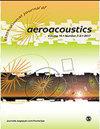封闭翼形风洞内翼型层流边界层旋涡脱落噪声的实验研究
IF 1.3
4区 工程技术
Q3 ACOUSTICS
引用次数: 0
摘要
本研究关注后缘噪声的实验特征,了解后缘噪声对于减轻主要行业的声污染至关重要。采用闭脉风洞对对称型NACA0021机翼在低雷诺数(Re≤163500)条件下的层流边界层涡脱落(LBL-VS)噪声进行了研究。进行了稳定的空气动力学和声学测量,涵盖了许多条件(流速从10米/秒到24.5米/秒,翼型入射从- 10°到10°)。气动结果表明,在失速前,翼型的吸力侧既表现出层流分离泡(LSB)和尾缘分离流-两者都使LBL-VS噪声可能发生。声学结果表明,在低速和中等发生率时,翼型发出一到两个音调,这都可以归因于LBL-VS噪声。特别是,它们各自的频率被看作是流速的0.8次方,而与入射角呈线性变化。在更高的速度下,这两种音调会消失,而其他更强烈的音调则会消失,而这些音调的频率既不随速度变化也不随入射频率变化。这些音调归因于来自混响环境对LBL-VS噪声发射的反作用的共振效应,然后通过声学反馈回路锁定到一些管道谐振频率。这些共振音调只有在流速和入射服从特定条件,即大致线性关系时才会出现,间接揭示了先前存在的LBL-VS噪声的存在。本文章由计算机程序翻译,如有差异,请以英文原文为准。
Experimental investigation of the laminar boundary layer vortex-shedding noise by an airfoil within a closed-vein wind tunnel
This study concerns the experimental characterization of trailing edge noise, the understanding of which is crucial for mitigating acoustic pollution across major industries. An aeroacoustic experiment is carried out using a closed-vein wind tunnel to investigate the laminar boundary layer vortex-shedding (LBL-VS) noise of a symmetric NACA0021 airfoil in low Reynolds number flows (Re ≤ 163,500). Steady aerodynamic and acoustic measurements are performed, with numerous conditions covered (flow velocity from 10 m/s to 24.5 m/s, airfoil incidence from −10° to 10°). The aerodynamic results reveal that, in the pre-stall regime, the airfoil’ suction side exhibits both a laminar separation bubble (LSB) and a trailing edge detached flow – which both make LBL-VS noise likely to occur. The acoustic results reveal that, when at low speed and moderate incidence, the airfoil emits one to two tones, which can be both attributed to LBL-VS noise. In particular, their respective frequency is seen to scale as the 0.8th power of the flow velocity, whereas varying linearly with the incidence. At higher speeds, these two tones vanish to the profit of other, more intense tonal emissions, whose frequency does not scale with the velocity nor the incidence. These tones are attributed to resonance effects coming from a retroaction of the reverberant environment onto the LBL-VS noise emission, which then locks-on to some of the duct resonant frequencies via an acoustic feedback loop. Revealing indirectly the presence of the pre-existing LBL-VS noise, these resonant tones emerge only when the flow velocity and incidence obey specific conditions, namely a roughly linear relationship.
求助全文
通过发布文献求助,成功后即可免费获取论文全文。
去求助
来源期刊

International Journal of Aeroacoustics
ACOUSTICS-ENGINEERING, AEROSPACE
CiteScore
2.10
自引率
10.00%
发文量
38
审稿时长
>12 weeks
期刊介绍:
International Journal of Aeroacoustics is a peer-reviewed journal publishing developments in all areas of fundamental and applied aeroacoustics. Fundamental topics include advances in understanding aeroacoustics phenomena; applied topics include all aspects of civil and military aircraft, automobile and high speed train aeroacoustics, and the impact of acoustics on structures. As well as original contributions, state of the art reviews and surveys will be published.
Subtopics include, among others, jet mixing noise; screech tones; broadband shock associated noise and methods for suppression; the near-ground acoustic environment of Short Take-Off and Vertical Landing (STOVL) aircraft; weapons bay aeroacoustics, cavity acoustics, closed-loop feedback control of aeroacoustic phenomena; computational aeroacoustics including high fidelity numerical simulations, and analytical acoustics.
 求助内容:
求助内容: 应助结果提醒方式:
应助结果提醒方式:


